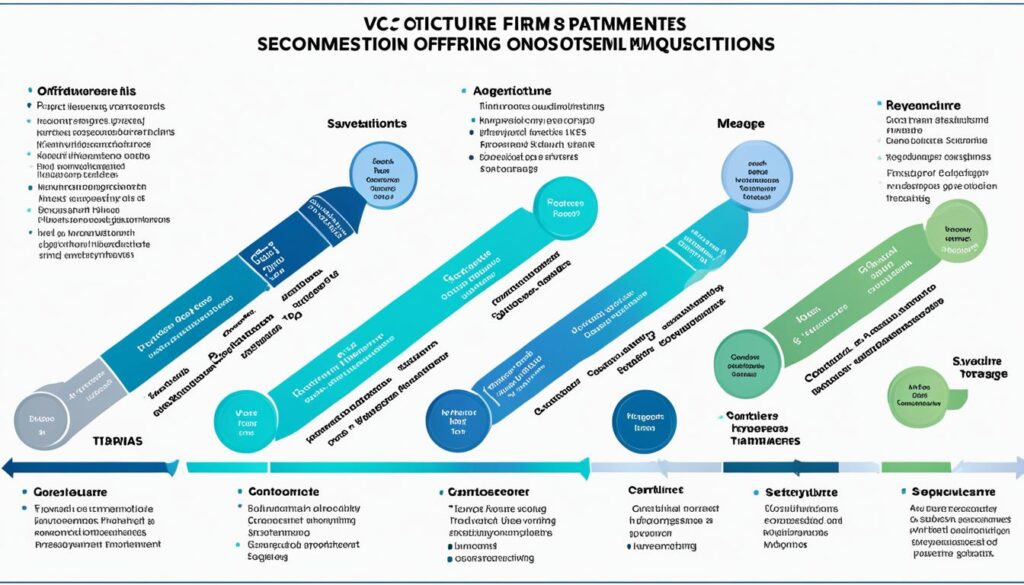In the dynamic world of venture capital (VC), the ultimate goal is not just to invest in promising startups, but to successfully exit those investments and generate substantial returns for their investors. VC firms typically navigate four main exit strategies: initial public offerings (IPOs), mergers and acquisitions (M&A), special-purpose acquisition companies (SPACs), and liquidation. But which path is the most lucrative, and how do VC firms determine the optimal timing and approach?
Understanding the various exit options and the factors that influence them is crucial for VC firms navigating the complex startup ecosystem. The choice of exit strategy often depends on the maturity of the company, market conditions, and the preferences of the founders and investors. Successful exits can generate significant returns, while less favorable outcomes can result in losses. By exploring the nuances of each exit strategy, VC firms can better position themselves to maximize the value of their investments and deliver strong returns to their stakeholders.
Key Takeaways
- VC firms typically exit their investments through four main strategies: IPOs, M&A, SPACs, and liquidation.
- The choice of exit strategy depends on factors like the company’s maturity, market conditions, and the preferences of the founders and investors.
- Successful exits can generate significant returns for VC firms and their portfolio companies, while less favorable exits can result in losses.
- Understanding the different exit options and how to time them effectively is crucial for VC firms navigating the complex startup ecosystem.
- Proper planning and alignment of stakeholder interests are key to executing a profitable and timely exit.
Understanding VC Firm Exits
In the dynamic world of startups and venture capital, the concept of an “exit” holds immense significance. An exit refers to the process by which a VC firm or entrepreneur sells their stake in a company, typically to realize a profit on their investment. These exits can take various forms, including initial public offerings (IPOs), mergers and acquisitions (M&A), and even liquidations.
What Is an Exit?
An exit is a crucial milestone in the life of a VC-backed company, as it represents the culmination of a successful investment journey. By selling their shares, VC firms and entrepreneurs can unlock the value they have created and reap the rewards of their efforts. Exits can provide a significant financial windfall, allowing VC firms to reinvest in new promising startups and entrepreneurs to pursue their next venture.
The Importance of Timing and Milestones
The timing of a VC firm’s exit is critical, as they aim to maximize the value of their investments by exiting at the right moment. Companies often work to reach key milestones, such as building a strong customer base and establishing a clear growth strategy, before pursuing an exit. Reaching these milestones can solidify the company’s value and appeal to potential buyers or public market investors, ultimately enhancing the chances of a successful and profitable exit for the VC firm.

Initial Public Offering (IPO)
One of the most common
VC firm IPO exits
is the initial public offering (IPO), where a company sells ownership shares to the public market. IPOs allow private companies to access more capital and gain greater publicity, while providing VC investors an opportunity to exit their positions and realize gains. A company will typically begin discussing an
IPO
once it has reached certain milestones, such as a private valuation of over $1 billion.
IPO Process and Requirements
The
IPO process
involves meeting stringent regulatory requirements and responsibilities to a broader set of stakeholders. Companies must navigate a complex set of legal, financial, and operational hurdles to successfully complete an IPO. This includes preparing detailed financial statements, obtaining regulatory approvals, and conducting extensive marketing and roadshow activities to attract investor interest.
IPOs in AV’s Portfolio
 Accolade
Accolade
,
Compass
, and
Upstart
, successfully complete
IPOs
. These
startup IPOs
have allowed AV to capitalize on the growth and success of its investments, generating returns for its investors.
Mergers and Acquisitions
Mergers and acquisitions (M&A) are another common
VC firm M&A exits
strategy for VC firms. Acquisitions involve one company purchasing another, granting the acquirer a majority stake. Mergers, on the other hand, combine two companies to form a single entity.
Acquisitions Overview
Acquisitions typically occur through mutual agreement, with the acquired firm’s shares purchased at a premium to the current market value. This allows VC investors to realize significant gains on their startup acquisitions when the acquired company’s valuation exceeds their original investment.
Merger Types and Examples
Mergers can be structured as either purchases or consolidations. In a purchase merger, one company buys the majority of another company’s stock or assets. In a consolidation merger, two companies combine to form a new, independent entity. Some examples of startup mergers in AV’s portfolio include Freshly’s acquisition by Nestlé and Humio’s acquisition by Crowdstrike.
Mergers and Acquisitions in AV’s Portfolio
VC firms like Alumni Ventures (AV) have seen a range of M&A types and M&A examples in their portfolio companies. In addition to the Freshly and Humio deals, AV has also witnessed the acquisition of JUMP Bikes by Uber, allowing the VC firm to capitalize on the growing micromobility market.

Special-Purpose Acquisition Companies (SPACs)
Special-purpose acquisition companies (SPACs) offer a unique exit strategy for VC-backed companies. Unlike traditional initial public offerings (IPOs), a SPAC first raises capital through an IPO and then seeks to merge with or acquire a private company, effectively taking the private company public.
Benefits of SPACs for Private Companies
SPACs can provide several benefits for private companies, including a faster timeline to going public and the ability to negotiate the terms of the public offering. This can be particularly appealing for VC-backed startups that are seeking a quicker path to accessing public markets and liquidity for their investors. Additionally, the SPAC structure allows private companies to have more control over the terms of their public debut, potentially resulting in a more favorable valuation and deal structure compared to a traditional IPO.
One notable example of a VC-backed company that went public via a SPAC merger is Wheels Up, an innovative private aviation company in the Alumni Ventures (AV) portfolio. In 2021, Wheels Up completed a SPAC merger, which provided the company with the capital and public market exposure to accelerate its growth and expansion plans.

Liquidation
Not all VC-backed company exits are successful, and some may result in liquidation. Liquidation occurs when a company is unable to pay its obligations and must sell off its remaining assets, often at a discount, to settle outstanding debts. The residual value, if any, is then distributed to shareholders according to a predetermined hierarchy.
Circumstances Leading to Liquidation
VC firms have seen some of their portfolio companies, such as Lumiata and Freebird, ultimately liquidate due to unforeseen market risks or an inability to achieve sustainable growth. These startup liquidations can be the result of various factors, including fierce competition, technological disruptions, or a failure to secure adequate funding for continued operations.
Liquidation Examples from AV’s Portfolio
While the majority of VC-backed companies strive for successful VC firm liquidation exits, there are instances where reasons for liquidation lead to less favorable outcomes. Alumni Ventures (AV) has encountered a few portfolio companies that have ultimately resorted to liquidation due to the challenges of navigating the dynamic startup landscape.

Exit Strategies for Different Investment Stages
VC firms and entrepreneurs must carefully consider the appropriate exit strategy based on the stage and maturity of the investment. The choice of exit can vary depending on factors like the company’s financial performance, market conditions, and the preferences of the founders and investors. For example, IPOs are typically pursued by more mature, high-growth companies, while acquisitions and SPAC mergers may be suitable for earlier-stage startups. Liquidation is often a last resort for companies unable to achieve a successful exit through other means. Proper planning and alignment of stakeholder interests are crucial for executing a profitable and timely exit.
| Exit Strategy | Typical Investment Stage | Key Considerations |
|---|---|---|
| IPO | Mature, high-growth companies | Regulatory requirements, broader stakeholder responsibilities, access to public markets |
| Mergers and Acquisitions | Early-to-mid stage startups | Negotiating deal terms, aligning stakeholder interests, strategic fit with acquirer |
| SPAC Mergers | Early-stage startups | Faster timeline to going public, negotiating merger terms, market conditions |
| Liquidation | Failing companies | Inability to achieve a successful exit, settling outstanding debts, distributing residual value |
VC firms and entrepreneurs must carefully weigh the pros and cons of each exit strategy based on the stage of their investment and the specific circumstances of their company. Proper planning and the alignment of stakeholder interests are critical for executing a profitable and timely exit, whether the company is pursuing an IPO, a merger or acquisition, a SPAC merger, or ultimately facing liquidation.

How do VC firms exit?
VC firms typically exit their investments through four main strategies: IPOs, M&A, SPACs, and liquidation. The choice of exit strategy depends on various factors, such as the company’s growth stage, market conditions, and the preferences of the founders and investors.
Common Exit Strategies for VC firms
Common exit strategies for VC firms include IPOs, which provide access to public markets and liquidity for investors; acquisitions and mergers, which allow VC firms to realize gains through a sale to another company; SPAC mergers, which offer a faster path to going public; and liquidation, which is a less favorable outcome but can still help minimize losses.
Factors Influencing VC Exit Decisions
The timing and success of a VC firm’s exit are influenced by factors like the company’s financial performance, technological advantages, and the overall economic environment. Understanding these factors affecting VC exits is crucial for VC firms to navigate the complex startup ecosystem and maximize the value of their investments.

Preparing for a Successful Exit
To maximize the chances of a profitable and timely exit, venture capital (VC) firms and their portfolio companies must focus on building value and aligning the interests of all stakeholders. This strategic approach is crucial for preparing for a successful VC firm exit.
Building Value Before Exiting
VC-backed companies must prioritize reaching key milestones, such as establishing a strong customer base, developing a clear growth strategy, and maintaining financial stability. By building startup value, these companies can increase their appeal to potential buyers or public market investors, ultimately commanding a higher valuation and generating greater returns for VC firms upon exit.
Aligning Stakeholder Interests
VC firms must work closely with their portfolio companies to ensure that the exit process is well-planned and executed, with the interests of founders, investors, and employees all taken into consideration. By aligning stakeholder interests, VC firms can navigate the complexities of the exit process and increase the likelihood of achieving a successful and mutually beneficial outcome.
By prioritizing value creation and stakeholder alignment, VC firms can increase the likelihood of achieving a profitable and timely exit, ultimately generating strong returns for their investors.

Conclusion
The venture capital (VC) ecosystem offers a diverse array of exit strategies for firms and their portfolio companies. From initial public offerings (IPOs) to mergers and acquisitions (M&A), special-purpose acquisition companies (SPACs), and even liquidation, VC firms have a range of options to consider when exiting their investments. Each strategy carries its own unique set of requirements, timelines, and potential rewards.
Successful VC firm exits can generate significant returns for investors, while less favorable outcomes may result in losses. Proper planning and alignment of stakeholder interests are essential for executing a profitable and timely exit. By understanding the various exit strategies and the factors that influence them, VC firms can navigate the complexities of the startup ecosystem and maximize the value of their investments.
As the startup landscape continues to evolve, VC firms must stay abreast of emerging trends and adapt their exit planning strategies accordingly. By leveraging the right exit strategy at the right time, VC firms can position their portfolio companies for long-term success and generate impressive returns for their investors.
